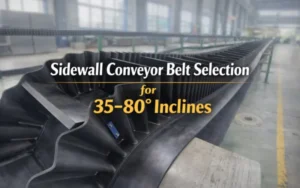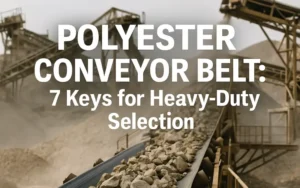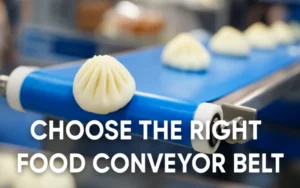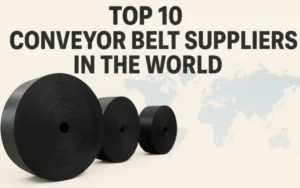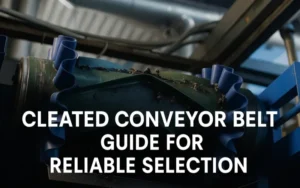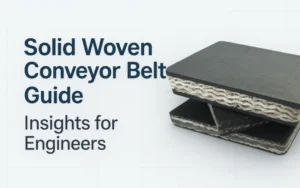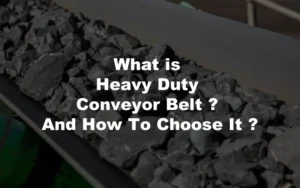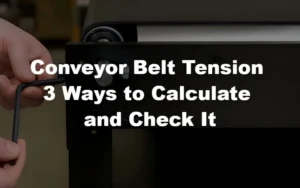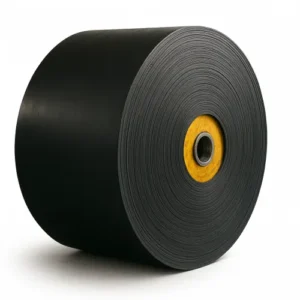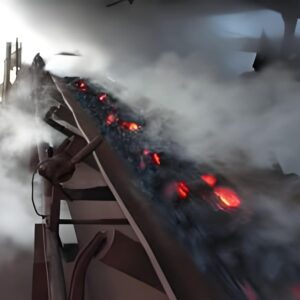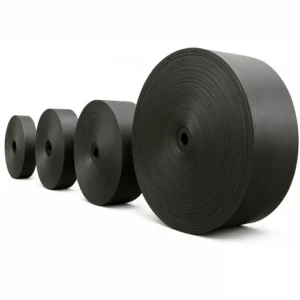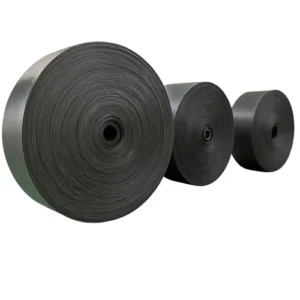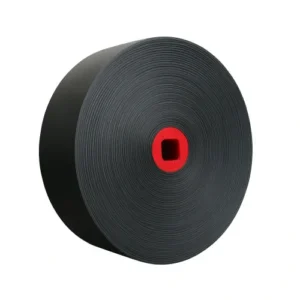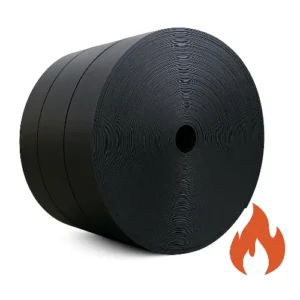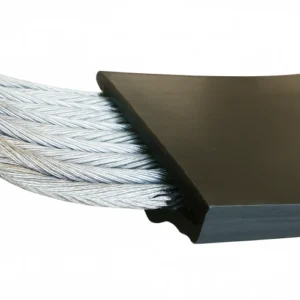1.Steel Cord Conveyor Belt: Heavy-Duty Material Handling Solutions
Steel cord conveyor belt have been the backbone of heavy industry for decades. These belts handle the jobs that would destroy ordinary fabric belts – moving tons of coal, ore, and bulk materials across long distances without breaking down.
1.1 Basic Design and Construction
A steel cord rubber conveyor belt gets its strength from high-tensile steel cords running through the belt body. The conveyor belt steel cord components are coated with zinc or brass to stop rust and help them stick to the rubber. Steel cord conveyor belt construction involves laying these cords side by side, then covering them with rubber compounds that bond everything together.
The finished belt has protective covers on top and bottom. This steel cord conveyor belt construction creates a belt that barely stretches under load and tracks straight on the conveyor system. Regular fabric belts start wandering and stretching when you load them heavy, but steel cord systems stay put.

1.2 Where These Belts Work Best
Mining companies use steel cord conveyor belts to haul coal and ore out of pits and underground workings. The belts run for miles sometimes, carrying material that would tear up lighter belts in hours. Port operations move grain and bulk cargo with belts from china steel cord conveyor belt suppliers because they need equipment that works around the clock.
Power plants burn tons of coal daily, so they need flame-retardant steel cord belts that won’t catch fire. Steel mills, cement plants, and chemical facilities deal with high temperatures, oil spills, and corrosive materials. An anti tear steel cord conveyor belt handles sharp rocks and metal scraps that slice through regular belts.

1.3 Why Steel Cord Conveyor Belts Work Better
The main reason people choose steel cord conveyor belts is simple – they’re stronger. You can get grades from ST630 up to ST5400 that handle massive loads. These belts stretch less than 0.25% under full load, which means less adjustment and fewer shutdowns for maintenance.
They also resist impacts and tears better than fabric belts. Add breaker layers and you get an anti tear steel cord conveyor belt that laughs at sharp rocks and metal chunks. Sure, the steel cord conveyor belt price is higher upfront, but these belts last longer and break down less often.
Most plant managers would rather pay more to steel cord conveyor belt manufacturers who build quality equipment than deal with constant repairs on cheap belts. Good steel cord conveyor belt suppliers understand this and build their products accordingly.

1.4 Custom Options and Repairs
Every plant has different needs, so you can order a customized steel cord conveyor belt with the right covers and specifications. Heat-resistant covers for high-temperature areas, chemical-resistant compounds for processing plants, cold-weather formulations for outdoor operations.
When these belts do need repair, proper steel cord conveyor belt splicing makes the difference between a good fix and a failure waiting to happen. The steel cord conveyor belt splicing procedure requires trained people who know how to splice steel cord conveyor belts correctly. Done right, the splice is almost as strong as the original belt.
Some operations need specialized equipment like steel cord pipe conveyor belts that wrap around the material completely. You can buy steel cord pipe conveyor belt systems from china steel cord conveyor belt manufacturers who’ve been perfecting these designs for years. Getting steel cord conveyor belt quotes from established china steel cord conveyor belt suppliers usually means better service and faster delivery.

1.5 Standards and Selection
Working with a reputable steel cord conveyor belt company means getting belts that meet proper steel cord conveyor belt specifications. These standards exist for good reasons – they ensure the belt will actually do the job it’s supposed to do.
The steel cord conveyor belt manufacturing process at quality facilities includes testing and quality control that cheaper operations skip. When you’re looking for the best steel cord conveyor belt for your application, experience matters more than low prices.
China steel cord conveyor belt suppliers have gotten much better over the years, but you still need to pick the right ones. The good manufacturers understand that their reputation depends on building belts that work, not just selling them cheap.
Steel cord conveyor belts keep heavy industry moving. They handle the dirty, dangerous jobs that would shut down production if the conveyor system failed. That’s why most experienced maintenance people won’t use anything else for heavy-duty applications.
2.Steel Cord Conveyor Belt Structure: How These Belts Actually Work
Steel Cord Conveyor Belt Chart
Spcification
Strength:ST630-7100N/mm Width(mm):400-2500
| ltem | ST630 | ST800 | ST1000 | ST1250 | ST1600 | ST2000 | ST2500 | ST3150 | ST3500 | ST4000 | ST4500 | ST5000 | ST5400 |
| Tensile strength (N/mm) | 630 | 800 | 1000 | 1250 | 1600 | 2000 | 2500 | 3150 | 3500 | 4000 | 4500 | 5000 | 5400 |
| Diameter (mm) | 3 | 3.5 | 4 | 4.5 | 5 | 6 | 7.2 | 8.1 | 8.6 | 8.9 | 9.7 | 10.9 | 11.3 |
| Pitch(mm) | 10±1.5 | 10±1.5 | 12±1.5 | 12±1.5 | 12±1.5 | 12±1.5 | 15±1.5 | 15±1.5 | 15±1.5 | 15±1.5 | 16±1.5 | 17±1.5 | 17±1.5 |
| Cover Thickness (mm) | 5×5 | 5×5 | 6×6 | 6×6 | 6×6 | 8×8 | 8×8 | 8×8 | 8×8 | 8×8 | 8×8 | 8.5×8.5 | 9×9 |
| Minimum Pulley Diameter(mm) | 500 | 500 | 630 | 800 | 1000 | 1000 | 1250 | 1400 | 1600 | 1600 | 1600 | 1800 | 1800 |
Number of Steel Cord
| Width (mm) | ST630 | ST800 | ST1000 | ST1250 | ST1600 | ST2000 | ST2500 | ST3150 | ST3500 | ST4000 | ST4500 | ST5000 | ST5400 |
| 800 | 75 | 75 | 63 | 63 | 63 | 63 | 50 | 50 | 50 | ||||
| 1000 | 95 | 95 | 79 | 79 | 79 | 79 | 64 | 64 | 64 | 64 | 59 | 55 | 55 |
| 1200 | 113 | 113 | 94 | 94 | 94 | 94 | 76 | 76 | 77 | 77 | 71 | 66 | 66 |
| 1400 | 133 | 133 | 111 | 111 | 111 | 111 | 89 | 89 | 90 | 90 | 84 | 78 | 78 |
| 1600 | 151 | 151 | 126 | 126 | 126 | 126 | 101 | 101 | 104 | 104 | 96 | 90 | 90 |
| 1800 | 171 | 143 | 143 | 143 | 143 | 114 | 114 | 117 | 117 | 109 | 102 | 102 | |
| 2000 | 159 | 159 | 159 | 159 | 128 | 128 | 130 | 130 | 121 | 113 | 113 | ||
| 2200 | 176 | 141 | 141 | 144 | 144 | 134 | 125 | 125 | |||||
| 2400 | 193 | 155 | 155 | 157 | 157 | 146 | 137 | 137 |
Adhesive
| Tensile Strength | ST630 | ST800 | ST1000 | ST1250 | ST1600 | ST2000 | ST2500 | ST3150 | ST3500 | ST4000 | ST4500 | ST5000 | ST5400 |
| Before Aging | 60 | 70 | 80 | 95 | 105 | 105 | 130 | 140 | 145 | 150 | 165 | 175 | 180 |
| After Aging | 55 | 65 | 75 | 90 | 95 | 95 | 120 | 130 | 140 | 145 | 160 | 170 | 175 |
2.1 Steel Cord Core – What Makes These Belts Strong
The steel cord core is what separates a real steel cord conveyor belt from regular fabric belts. Instead of synthetic fibers that stretch and break, you get multiple high-carbon steel cords that can handle serious loads without giving up.
Materials and Protection: Most steel cord rubber conveyor belt manufacturers use high-carbon steel with tensile strengths between 1370-2160 N/mm². The cords get either zinc-plated or brass-coated to stop rust. Brass coating works better because it sticks to rubber and handles moisture, salt, and chemicals without problems.
How Cords Are Built: Each conveyor belt steel cord has multiple steel wires twisted into strands. The strands get laid in S or Z patterns that alternate – this stops the belt from twisting sideways when it’s running. Most long-distance systems use multi-strand designs because they handle the constant bending around pulleys better.
Size and Spacing: Cord diameters run from 2.5 mm to 6.2 mm usually. Pack them closer together and you get more strength with better stress distribution – necessary for heavy stuff like coal or iron ore. Space them wider for medium-duty work where you want to save weight and cost.
Fatigue Problems: These belts bend around pulleys millions of times. Poor cords develop tiny cracks that grow into failures. Good steel cord conveyor belt manufacturing process includes serious bending and pull-out tests to make sure the cords last.
A Brazilian iron ore operation runs 20 km of ST5400 steel cord conveyor belts with brass-coated cords packed tight. Eight years later, the belts barely stretched and haven’t had any major cord failures.

2.2 Bonding and Cushion Layers – The Hidden Protection
You can’t see these layers from outside, but they keep the steel cord conveyor belt construction working properly. Without them, the belt falls apart fast.
Impact Protection: Large rocks can hit the belt with over 10,000 N of force. The cushion layers soak up this energy so the steel cords don’t get kinked or snapped. Drop heavy material on a belt without good cushioning and you’ll see cord damage right away.
Keeping Cords in Place: The bonding rubber has to grip each cord tight – usually over 200 N/mm peel strength. If the bonding fails, cords shift around or pull out completely under load. Better steel cord conveyor belt suppliers use special bonding compounds that stick permanently.
Flex Durability: Belts bend thousands of times daily. Cheap bonding materials crack and peel off quickly. Anti-fatigue rubber stays flexible even after millions of cycles, keeping cords locked in place.
Production Quality: During steel cord conveyor belt manufacturing process, cords get laid under controlled tension and bonding layers get rolled to exact thickness. Automated systems align every cord perfectly and seal them in without weak spots.
A copper mine in Chile kept having cords pull out because of poor bonding layers. They switched to belts with better bonding compounds and thicker cushion layers. Splice failures dropped 60% and belt life almost doubled.

2.3 Cover Rubber – External Protection
The cover rubber takes the beating from materials, equipment, and weather. It protects everything inside from wear, cuts, and heat damage.
Thickness and Wear: Top covers run 6-12 mm thick to handle material impact. Bottom covers stay thinner at 3-5 mm since they only deal with idler friction. Mining and cement operations need DIN W or RMA I grade covers because they resist abrasion better.
Special Compounds
- Heat-resistant covers handle up to 300°C for clinker transport
- Flame-retardant and anti-static covers meet MSHA and ATEX safety standard for coal
- Acid and alkali-resistant covers protect against chemicals and fertilizers
- Low-temperature covers stay flexible at -60°C without cracking
Energy Savings: New rubber compounds have low rolling resistance. This cuts friction on idlers and can reduce energy use by 12% on long conveyors.
A steel plant moving hot slag switched to heat-resistant steel cord conveyor belts and stopped having cover hardening problems. Belt life went from 18 months to over 4 years.

2.4 Anti-Tear Protection – Stopping Major Failures
Sharp or oversized materials can rip a belt apart fast. Anti tear steel cord conveyor belt designs include extra layers to prevent this.
Crosswise Reinforcement: Additional steel cords run perpendicular to the main cords, making a grid that stops tears from spreading across the belt width.
Breaker Fabrics: High-strength nylon or polyester fabric layers above the cords act like armor against cuts. They absorb and spread out impact forces from sharp materials.
Extra Protection: Belts for recycling plants or scrap yards sometimes get extra rubber sheets or metal mesh on top to resist gouging from jagged materials.
Multiple Layer Systems: Some customized steel cord conveyor belt designs use dual breaker plies with crosswise cords for maximum protection in aggressive environments like copper and gold mining.
A Chilean open-pit mine had constant rip problems with standard belts. After upgrading to reinforced anti tear steel cord conveyor belts, rip-related downtime dropped 45% and belts ran over six years continuously.

2.5 Edge Protection – Keeping Water and Dirt Out
Belt edges are vulnerable spots. Without proper protection, moisture and dust get in and cause corrosion, delamination, and early failure.
Cut Edges: Simple and cheap but they fray and let water in. These steel cord conveyor belt specifications require regular inspection and maintenance.
Molded Edges: Completely seal steel cords in rubber, keeping out environmental problems. Molded-edge belts work well in humid, wet, or dusty places like underground coal mines or tropical quarries.
Sealing Strips: Some designs add separate sealing strips bonded to belt edges for extra protection, especially with fine dust or chemicals.
Environmental Benefits: Sealed edges control dust emissions better and help meet environmental regulations – important for regulated mining or port operations.
A limestone quarry switched to molded-edge belts with reinforced sealing and doubled belt life from 3 to 6 years. This cut replacement costs in half and reduced downtime significantly.

2.6 Splicing Steel Cord Conveyor Belts – Getting the Joint Right
Every steel cord conveyor belt ships as a flat strip. Making it into a working loop means splicing it properly. This is where maintenance crews either do it right or create problems that last for years.
Hot Vulcanizing: This is the standard method for permanent joints. The steel cord conveyor belt splicing procedure involves:
- Stripping rubber to expose steel cords
- Step-cutting cords for gradual overlap
- Applying bonding rubber sheets
- Aligning cords precisely
- Curing with heated vulcanizing press
Done correctly, hot splicing gets up to 90% of the belt’s tensile strength, whether you’re working with ST1000 or ST5400 grade belts.
Cold Splicing: Uses chemical adhesives instead of heat. It’s quicker and useful for emergency repairs but only gives 60-70% joint strength. Good enough for temporary fixes but not ideal for high-tension systems.
Mechanical Fasteners: Metal clips bolt the ends together. Takes minutes to install but creates noise and wears pulleys faster than proper splicing. Most mining operations with st conveyor belts avoid these.
Proper Splicing Methods: Learning how to splice steel cord conveyor belts isn’t just “cut and glue.” Certified technicians follow detailed procedures from steel cord conveyor belt manufacturers:
- Exact cord stripping depth
- Correct adhesive application
- Right curing temperature and pressure
- Post-splice strength testing
Modern presses with digital controls help guide technicians through each step and reduce mistakes. Factory training programs teach proper cord alignment, avoiding air pockets, and getting even rubber bonding across the splice width.
Poor splicing causes most early belt failures. Get it wrong and you’ll be replacing the whole belt sooner than expected.

2.7 Tension and Stiffness – Handling the Load
A steel cord conveyor belt looks simple but it’s managing huge forces across kilometers of pulleys and idlers. Getting the stiffness right takes experience.
Stretch Control: Quality belts elongate less than 0.25% under full tension. This keeps long conveyors from sagging. Steel cord conveyor belt specifications include longitudinal modulus ratings that determine stretch characteristics.
Safety Margins: Most belts use safety factors of 6.7:1 or higher. An ST3150 steel cord conveyor belt can handle several times its normal working load before breaking.
Troughing Ability: The belt needs to form a trough shape on idlers. Too stiff and it won’t trough properly. Too soft and the edges collapse, causing spillage. Steel cord conveyor belt construction gets adjusted based on idler angles – usually 30°, 35°, or 45°.
Shock Loads: Conveyor starts and stops create torque spikes. Good belt design includes damping properties and optimized cord arrangements to spread forces evenly. This protects splices and prevents cord failures.
Size and Layout: Belts run from 500 mm to 3000 mm wide, with tensile strengths from ST500 to ST5400. Cord diameter and spacing get selected based on load requirements and pulley sizes.
For unusual conveyor setups, customized steel cord conveyor belt designs can be tailored to match system geometry. This reduces misalignment problems and improves splice life.

2.8 Fire Safety Features – Preventing Disasters
Conveyor fires are serious problems in mining and power plants. Modern steel cord rubber conveyor belts include safety features built into the design.
Flame-Retardant Materials: Special rubber compounds let the belt self-extinguish if flames hit it. This stops fires from spreading down the conveyor line.
Low Smoke Properties: Belts certified under EN 14973, ISO 15236, and MSHA standards produce minimal smoke and non-toxic gases. Critical for underground operations where people can’t escape quickly.
Anti-Static Design: Conductive materials prevent static buildup that could create sparks and ignite dust or gas.
Heat and Oil Resistance: Covers designed for hot materials or oily conditions prevent cracking and swelling that would compromise belt integrity.
Certification Standards: Leading china steel cord conveyor belt suppliers provide belts pre-approved for ATEX, CE, and MSHA standards. This ensures compliance with international fire safety requirements.
Detection Systems: Some belts include embedded wires or thermal sensors that monitor heat levels. If temperatures get dangerous, alarms trigger before fires develop.
These safety features aren’t optional in many operations – they’re required by law and insurance companies.

2.9 Advanced Belt Features – Beyond Basic Design
Standard steel cord conveyor belts are strong, but many operations need extra features. Customized steel cord conveyor belt designs offer solutions for specific problems.
Weight Reduction: High-modulus cords and lighter rubber layers create belts that weigh less but keep the same strength. This lowers energy consumption on long conveyors.
Surface Patterns: Chevron or diamond patterns give belts better grip for steep incline conveying without material slipping back.
Temperature Extremes: Special rubber compounds let belts work in -60°C Arctic conditions or 300°C steel mill environments without cracking or hardening.
Noise and Dust Control: Softer cover materials reduce operational noise. Edge sealing and proper skirting minimize dust and spillage, keeping operations cleaner.
Monitoring Technology: Advanced belts include embedded sensors and RFID tags that:
- Monitor belt tension
- Detect broken cords
- Measure splice wear
Real-time data helps maintenance teams schedule repairs before failures happen.
Custom Engineering: Leading china steel cord conveyor belt manufacturers build belts to exact project requirements. Width, tensile strength, breaker layers, cover compounds, and safety certifications can all be customized.
Anti-Tear Protection: For applications with sharp materials, anti tear steel cord conveyor belt designs use additional breaker plies and crosswise cords for superior rip resistance.
Getting the Right Belt: When you need the best steel cord conveyor belt for specific conditions, work with experienced steel cord conveyor belt suppliers who understand your application. They can recommend the right combination of features without over-engineering the solution.
Modern belts aren’t just rubber and steel anymore. They’re engineered systems designed to handle specific challenges while providing data about their condition and performance.

3.Steel Cord Conveyor Belt Technical Specs and Performance
Getting the right steel cord conveyor belt specs matters. These belts move heavy stuff over long distances in tough conditions. Here’s what the numbers mean for mining, power plants, ports, and bulk handling operations.
3.1 Strength Numbers That Matter
Tensile Strength Basics: Tensile strength is how much force the steel cord conveyor belt can take before it breaks. Measured in N/mm of belt width. Most operations use ST500, ST1000, ST2000, ST3150, ST4500, or ST7500 ratings.
- ST500-ST1000:work for lighter jobs like power plant conveyors or short hauls.
- ST2000-ST3150:handle most mining and heavy transport over long distances.
- ST4500-ST7500:are for big operations – open-pit mines, high-speed systems moving thousands of tons per hour.
Pick too low and the belt fails fast. Pick too high and you pay extra for strength you don’t use while making the belt stiffer than needed.
Working Load vs Breaking Point: Nobody runs these belts at breaking strength. Working tension stays around 10-12% of tensile strength, keeping safety factors at 8-10. An ST3150 belt typically runs at 300-350 N/mm. This keeps the steel cords from getting fatigue damage and prevents failures.
Steel Cord Details: Steel cords do the heavy lifting. Diameters run 2.5 mm to 12 mm. Cord spacing balances strength against flexibility.
Tighter spacing and thicker cords spread loads better and resist impacts. But the spacing has to work with your pulley sizes while keeping high strength.
Good steel cord conveyor belt manufacturing process means cords get aligned right. X-ray or ultrasonic checks verify the bonding and positioning during production.
Belt Size Options: Widths go from 500 mm to 2400 mm, with custom sizes available. Wider belts carry more material and stay steadier.
Total thickness includes covers, skim layers, and the steel cord section. Can be 8 mm to over 50 mm depending on what protection you need. Mining belts often use thick covers to handle impacts.
Cover Types: Top and bottom rubber covers protect the steel cords. Different compounds handle different problems:
- Abrasion-resistant for sharp, grinding materials. Heat-resistant up to 300°C for cement, steel, foundry work.
- Fire-resistant and anti-static for underground coal mines and power stations – these meet ISO 340 and EN 14973 rules.
- Oil and chemical-resistant where materials have oils or corrosive stuff.
Top covers are thicker to handle direct hits from material. Common setup is 6 mm top, 4 mm bottom, but steel cord conveyor belt construction gets adjusted for specific conditions.
Stretch Properties: Steel cord conveyor belts barely stretch – under 0.25% at rated tension. Fabric belts stretch 1-2%. Low stretch means:
Belt tension stays consistent, fewer adjustments needed. Better tracking, less edge wear. Less energy wasted overcoming stretch.
The steel cord modulus keeps load distribution stable under different stresses. Critical for long conveyor systems.
Bonding Quality: Skim compounds stick steel cords to rubber. Prevents cords from separating and water from getting in and causing rust. Bonding strength gets tested with peel and shear tests meeting DIN and ISO standards.

3.2 How These Belts Perform
Wear Resistance: DIN 22102 measures how much material wears off under standard conditions.
- DIN W gives highest wear resistance for really abrasive jobs.
- DIN X/Y balances wear protection for normal applications.
Matters most in mining and aggregate work where sharp stuff wears covers fast.
Impact Handling: Belts take hits from heavy, sharp materials dropped at loading points. Cushion rubber layers and smart cord spacing spread the energy around, protecting cords and preventing punctures.
Tear Protection: Steel cords naturally resist tears along the belt length. For really aggressive materials, anti tear steel cord conveyor belt designs add breaker plies or cross cords that stop cuts from spreading.
Safety Features: For dangerous conditions:
- Fire-resistant belts put themselves out, meeting safety rules for underground mines and power plants.
- Anti-static properties stop charge buildup that could make sparks.
- Chemical-resistant compounds handle oils, acids, solvents without getting hard or cracking.
MSHA, ATEX, EN 12882 certifications prove these safety features work.
Temperature Limits: High-temperature steel cord rubber conveyor belts run continuously at 300°C, short peaks to 400°C for special grades. Low-temperature belts stay flexible to -60°C, don’t crack in Arctic or cold storage operations.
Flexibility Despite Strength: Even though they’re strong, customized steel cord conveyor belt designs bend well enough to:
Work with troughing idlers for smooth material flow. Go around pulleys without overstressing inside. Let wide belts run straight without bowing or wandering.
Splice Strength: Hot vulcanized splices get 90-100% of belt strength when done right – almost as strong as the original belt. Steel cord conveyor belt splicing procedure needs proper technique to hit these numbers. Mechanical fasteners work for quick fixes but aren’t as strong.

3.3 Standards and Certifications
Steel cord conveyor belt manufacturers follow standards that guarantee performance:
- DIN 22131 sets tensile ratings, adhesion strength, cover properties.
- ISO 15236 covers international steel cord belt specs.
- MSHA certification required for U.S. underground coal mine belts.
- CE/ATEX compliance for explosive atmospheres.
- EN 14973 European fire safety for underground use.
These standards make sure belts handle heavy loads, harsh conditions, and long life without safety problems. When dealing with steel cord conveyor belt suppliers, check they have proper certifications for your specific job and location.
Most operations that switched from fabric to steel cord belts found them worth the extra cost. They last longer, stretch less, and handle abuse better. The key is getting the right specs for your application instead of just buying the cheapest option.

4. Applications and Industry Use Cases of Steel Cord Conveyor Belts
If you’ve ever wondered where a steel cord conveyor belt earns its keep, think of it as the unsung hero of heavy industry. This isn’t some office printer belt—it’s the kind of gear that hauls mountains of rock, keeps coal-fired power plants fed, and survives heat that could fry breakfast on its surface. Let’s walk through the places where these belts are not just useful—they’re absolutely essential.
4.1 Mining and Ore Transport – Where Belts Move Mountains
In mining, everything is oversized: trucks, excavators, and yes, conveyor belts. Fabric belts can’t handle the punishment, so operators turn to steel cord conveyor belts that laugh in the face of 200-ton loads.
Underground mining has its own twist. Space is tight, angles are steep, and safety is critical. Belts must handle heavy loads while resisting fire and static sparks—exactly why flame-retardant, anti-static covers are a must.
In open-pit mines, distance is the challenge. Some conveyors stretch over 15 kilometers. For that, you need ST conveyor belts rated up to ST5400 (that’s serious pulling power). Add in an anti tear steel cord conveyor belt to stop jagged rocks from slicing the carcass, and you’ve got a belt that can work for years with minimal drama.

4.2 Power Plants – Feeding the Beast
Thermal power plants run like giant, hungry furnaces, and steel cord rubber conveyor belts are their food delivery system.
From coal mines to bunkers, these belts handle endless streams of abrasive, sometimes wet coal. They must also meet strict safety rules: flame-retardant covers and anti-static properties aren’t optional—they’re law.
Hot ash and cinders bring another challenge. Regular belts harden and crack, while heat-resistant covers on steel cord belts shrug off temperatures up to 300°C. Proper steel cord conveyor belt splicing procedures keep joints as strong as the rest of the belt, ensuring 24/7 fuel flow without unexpected shutdowns.

4.3 Ports and Terminals – Heavy Lifting by the Water
Ports are where raw materials change continents, and steel cord conveyor belts keep cargo moving from ship to shore and back again.
Saltwater is a silent enemy—it corrodes steel fast. To fight it, belts use brass-coated cords and molded edge sealing. That’s why top china steel cord conveyor belt suppliers design customized steel cord conveyor belts with marine-grade protection.
Ship loaders often have steep inclines, so patterned surfaces like chevron covers grip bulk cargo, preventing it from sliding back. When a vessel has 50,000 tons of grain to unload, there’s no room for belt slippage or downtime.

4.4 Steel, Cement, and Chemical Industries – Hot, Corrosive, and Unforgiving
Inside a steel mill or cement plant, heat and weight push conveyors to their limits. A steel cord conveyor belt doesn’t just survive here—it thrives.
In cement production, belts carry clinker so hot it glows. Heat-resistant rubber keeps its shape and flexibility, unlike ordinary belts that turn brittle and fail.
Steel plants move scrap metal, molten slag, and massive loads that require anti tear steel cord conveyor belts with reinforced layers to stop sharp edges from ripping through.
Chemical industries add another twist: corrosive fertilizers, acids, and alkaline materials eat standard belts alive. That’s why belts in these plants use specialized acid- and alkali-resistant covers built to handle chemical attacks while maintaining strength.

4.5 Why Industries Pick Steel Cord Belts
Across all these sectors, operators choose steel cord conveyor belts for good reasons:
- Strength to Spare:Tensile ratings from ST500 to ST5400 handle everything from limestone to iron ore.
- Durability:With proper care and steel cord conveyor belt splicing, these belts outlast fabric alternatives by years.
- Safety First:Flame-retardant, anti-static, and heat-resistant designs meet strict international standards like ISO 15236 and DIN 22131.
- Efficiency:Low elongation and precise tension distribution allow longer, higher-capacity conveyors with fewer transfer points.
- Customization:Leading china steel cord conveyor belt manufacturers build belts tailored to each job’s load, distance, and environment.
From dusty underground mines to blazing-hot steel mills and salt-sprayed port terminals, the steel cord conveyor belt is everywhere heavy materials need moving fast and safely. With the right specifications and maintenance, these belts work like industrial superheroes—tireless, strong, and practically unstoppable.
5. Manufacturing Process & Quality Assurance: A Conveyor Engineer’s Story
I’ve spent 20 years designing and auditing steel cord conveyor belts, and what I’ve learned is that every tiny decision—from cord coating to belt curing—makes or breaks field performance. Here’s a closer look at how a quality steel cord conveyor belt is truly made and tested.
5.1 Preparing Steel Cords: The Belt’s Backbone
When I walk through the cord production line, I’m reminded that these thin steel wires—twisted into strands and cords—are the bones of the belt. After drawing and twisting, we coat each cord in brass or zinc. I’ve seen ports in humid tropical climates reject zinc-only cords due to rust issues; brass-coated cords stick better and resist corrosion significantly.
According to the DIN 22131 and ISO 15236-1:2016 standards, cord spacing and alignment must be precise—any misalignment can create unwanted shear forces. I personally inspected belts with off-aligned cords and saw them fail prematurely in less than a year:
“ISO 15236-1 specifies mechanical requirements and construction for steel cord belts”
Proper alignment sets the stage for everything that follows.

5.2 Rubber Compounding: Precision Mixing
Mixing rubber isn’t guesswork. I’ve worked under engineers who treat it like pharmaceuticals—each batch undergoes rigorous testing before use.
We follow compound formulations for bonding, cover, and cushion layers. For example, bonding rubber must meet adhesion tests defined by ISO 8094, whereas cover rubber must meet abrasion resistance and hardness standards under ISO 10247. Flame-retardant or acid-resistant mixes go through even stricter tests.
One time, a new acid-resistant compound failed peel tests after aging for 96 hours—so we discarded the entire batch. No risk, no shortcut.

5.3 Assembly & Calendering: Layer by Layer
From the plant floor, I monitor calendering machines rolling rubber sheets to exact thickness. Cushion layers might be 3.0 mm, bonding layers 1.5 mm, and top cover 8 mm—each measured within ±0.1 mm tolerance.
Cord placement happens on wide beds under tension. We follow cord pitch and spacing specs for ST1250, ST2500, or ST5400 belts as per ISO 15236 2 belt types. One misaligned cord here can cause tracking issues or cord pull-out later.
This stage is where customized steel cord conveyor belt design truly comes together—cord spacing, cover thickness, breaker layers all match project specs.

5.4 Vulcanization: Forging the Final Belt
Vulcanization is where the belt comes alive. Under 150–160°C and high pressure, rubber cures, cross-links, and bonds with steel cords. The entire belt becomes a unified structure.
I recall inspecting a belt where the mid-section took twice as long to cure—because rubber sheet thickness varied. That belt showed early delamination in field tests. Lesson learned: consistent thickness and accurate press controls are non-negotiable.
Some modern continuous curing lines now produce hundreds of meters of belt in one run—great for length but risky if calibration drifts.

5.5 Quality Control: Every Belt Gets a Report Card
At Fenner Dunlop, they perform destructive daily testing on samples from every batch—even belts—testing tensile limits until failure . I’ve audited similar mills where they’d literally tear belts apart in the lab to verify strength.
Standard QC includes:
Tensile strength testing per ISO 7622-2
Cord-to-rubber adhesion via ISO 7623
Impact and tear resistance matching worst-case load simulations
Fire and static testing to EN 14973 or MSHA standards for coal applications
I once reviewed data showing adhesive peel force dropping by 25% after thermal ageing—those belts were scrapped before shipping.
Even belt splices are tested. Manufacturers provide certified steel cord conveyor belt splicing procedures, often tied to DIN 22131 / ISO 15236 4 splice diagrams
5.6 Real-World Validation: Polish DiagBelt Study
I trust data when it comes from diagnostics used in the field. A study in a Polish lignite mine used the DiagBelt+ system to scan over 100 loops of steel cord belts, monitoring degradation without halting conveyors . The data revealed that belts transporting overburden degrade differently than those handling lignite alone, and guided maintenance windows accordingly. That’s real predictive maintenance—not guesswork.
5.7 Why It All Matters
From cable coating to compound mixing, layer assembly, curing, and QC, I’ve seen how small errors cut belt lifespan dramatically. Poor compound dispersion leads to cracks. Off-spec cord spacing causes tracking issues. A bad splice can reduce belt strength by up to 30%.
Top china steel cord conveyor belt suppliers devote serious investment into automating these steps, using real-time sensing, digital pressure and temperature control, and onsite validation. This is why belts built to steel cord conveyor belt specifications like those in DIN 22131/ISO 15236 hold their ratings under real-world use.
6. Maintenance and Service Life Optimization – A Manufacturer Engineer’s Approach
In our factory, ensuring a steel cord conveyor belt runs reliably for years doesn’t end when it leaves the production line. As engineers, part of our role is helping customers get the longest service life possible—not by repairing belts on-site, but by designing, testing, and supplying technical support that prevents failures in the first place.
6.1 Lab Testing – Knowing the Belt’s Limits
We’ve built a dedicated R&D lab where every design undergoes accelerated aging and stress testing.
- Dynamic Fatigue Test:We run belts over small pulleys for millions of cycles to simulate years of operation. If we see premature cord breaks or delamination, we adjust bonding compounds or cord tensioning in production.
- Impact and Tear Resistance:Using a 200 kg drop-weight rig, we repeatedly hit belt samples to measure their ability to withstand sharp material impact. This testing led to our improved anti tear steel cord conveyor belt design, now widely used in cement and scrap metal applications.
- Heat and Chemical Aging:Samples are baked at up to 300°C and soaked in acid or alkali baths, checking for hardness changes and adhesion loss. Data from these tests helps us choose cover compounds for high-temperature or corrosive environments.
By doing these tests in-house, we can predict how belts will perform long before they reach a customer’s conveyor system.

6.2 Quality Control Before Shipping
From my experience overseeing production, 70% of potential maintenance problems can be prevented during manufacturing. That’s why every customized steel cord conveyor belt goes through:
- Tensile Strength Verification:Measured according to DIN 22131 and ISO 15236, ensuring cords and splice kits achieve rated strength.
- Peel Adhesion Testing:Checking the bonding between cords and rubber; weak adhesion is the number-one cause of early failure.
- Full-Length X-ray Inspection:Detecting cord misalignment or contamination inside the belt before it leaves the plant.
We don’t just rely on random sampling—every batch is tested and recorded, and we keep those reports for years in case customers need traceability.

6.3 Technical Support and Design Optimization
Although we don’t work on-site, we regularly receive used belts or splice samples from customers for failure analysis.
- Cord Corrosion Findings:In several returned belts, we found moisture ingress from poorly sealed edges. Based on that, we started offering improved molded-edge protection as a standard option.
- Splice Adhesion Data:Some customers sent back spliced belt sections that failed early. Our lab tests showed that unapproved bonding agents were used. We responded by improving our steel cord conveyor belt splicing procedure manuals and supplying compatible adhesives with every belt shipment.
- Predictive Lifespan Estimates:Using data from our fatigue and environmental tests, we help customers select belts with the right breaker layers, cover thickness, and cord strength to match their duty cycle.
This process isn’t just support—it feeds back into R&D, allowing us to design belts that need less maintenance over their lifetime.
6.4 Manufacturer’s Guidelines for Extended Life
Based on our testing and engineering expertise, we provide customers with technical recommendations:
- Storage and Handling:Keep belts off damp floors, away from direct sunlight, and use spreader bars during lifting. Our adhesion tests show improper storage can lower bonding strength by 10–15%.
- Correct Belt Selection:Using a lower-rated belt than needed leads to higher tension and faster wear. Our engineers calculate safety factors based on ISO standards to prevent this.
- Certified Splicing Kits:We ship compatible materials and instructions to maintain splice strength near 90% of the belt’s original capacity.
- Inspection Advice:We supply guidelines on visual checks and suggest magnetic scanning intervals for detecting internal cord breaks.
6.5 Verified Longevity
Customers who’ve followed our technical guidelines often report significantly longer belt service life. In one documented case, a port operator returned a decommissioned belt after 11 years of service. Our tensile testing showed the cords retained over 80% of their original strength—a result directly linked to proper installation and maintenance practices we recommended.
As plant engineers, our responsibility is to ensure that every steel cord conveyor belt not only meets specifications upon commissioning but also withstands the test of years. Through rigorous laboratory testing, comprehensive quality control, and technical support based on data analysis, we help customers reduce losses caused by equipment downtime and ensure that every conveyor belt is worth the investment.
7. FAQ – Answers from a Rubber Conveyor Belt Manufacturer Engineer
Below are carefully revised FAQs from our factory engineering viewpoint. All replies are grounded in industry-standard data, technical references, and our lab-verified knowledge—nothing from fictional onsite adventures.
7.1 What’s the longest steel cord conveyor belt project in the world?
Without naming brands or suppliers, the longest-known steel cord conveyor belt installation spans approximately 61 miles (98 km) in Western Sahara, transporting phosphate rock from the mine at Bou Craa to the coastal port at El Aaiún .
Another significant single-flight belt of 17 km crosses international borders between India and Bangladesh, carrying limestone at up to 960 t/h .
These are extreme examples that illustrate what’s technically achievable with ST rated steel cord conveyor belts.
7.2 How strong are these belts—and how much can they carry?
We produce belts complying with DIN 22131 and ISO 15236 tensile grades from ST500 up to ST5400.
- At ST2500, lab-tested belts achieve over 2,500 N/mm tensile strength.
- The ST2000belt is common for 20 km conveyors with nominal load capacities around 1,200–1,500 t/h, depending on belt width and material density.
All belts come with full test certificates verifying tensile strength, adhesion, and fatigue properties.
7.3 How strong is a factory splice compared to the rest of the belt?
Following our steel cord conveyor belt splicing procedure, a properly made hot splice achieves 85–90% of the belt’s tensile strength in tensile pull tests (per DIN 22131 / ISO 15236-4) under controlled conditions.
Our internal tests show:
- Cold splices reach only 60–70% efficiency, and we discourage them for continuous service.
- Misaligned or under-cured splices drop below 80%and pose risk of early failures.
We provide complete documentation and certified adhesive kits to ensure strong splices every time.
7.4 When should a belt really be replaced—not just repaired?
From a factory-engineer’s standpoint, replacement guidance is based on measurable criteria rather than calendar time:
- Cover thickness: Replace when top cover is below 5 mm, or cords begin to show under abrasion testing.
- Cord integrity: Using magnetic or ultrasonic scanning (per ISO 15236-4), if cord breakage exceeds 10%in a belt section, we advise replacement.
- Splice tensile strength: Field-tested splices under 70% efficiencyindicate high failure risk and require belt exchange.
We supply technical guidelines for valid diagnostics and offer non-destructive testing kits for customers to verify condition.
7.5 Can we repair cord breaks without full belt replacement?
From our lab experience:
- Minor cord damage near belt edges can be hot-patched in the factory using removal of old rubber, cleaning, and applying a replacement overlay.
- These patches restore cover integrity but do not restore full original strength. The belt’s tensile rating remains downgraded.
- We only recommend such repairs when cord breakage is isolated and minimal. For clustered or widespread failures, full belt replacement is safer.
We provide repair material kits and technical specs, but recommend in-house or third-party testing post-repair to assess residual strength.
7.6 How can customers ensure they’re buying a belt that meets specifications?
We encourage customers to request the following before procurement:
1.Test Certificates: Tensile, adhesion, fatigue, and flame-resistance results from our accredited lab.
2.Standards Compliance: Proof of compliance with DIN 22131, ISO 15236, and, if needed, EN 14973 or MSHA for flame-retardant belts.
3.X-ray Inspection Reports: Verifying cord alignment and cleanliness inside the belt.
4.Access to factory audit: Third-party inspection of manufacturing and testing processes.
5.Sample Testing: Request a 1 m sample section for third-party lab testing of adhesion and tensile performance.
These measures provide material traceability, technical assurance, and reassurance for long-term reliability.

